Key Signature Guide: Memorization Tips & Charts
In our key signature guide, learn these easy memorization tips for major and minor keys, as well as key signature charts for reference.

When you are first learning your musical key signatures, it can feel a little overwhelming. With twelve major keys and twelve minor keys, the sharps and flats pile up fast, and it can be easy to get them all mixed up. While you could hit the flashcards and memorize each key signature one at a time, we are going to save you some time by giving you the best key signature hacks!
Our aim is for you to view the key signature as your trusty guide for identifying major and minor keys. Key signatures let you know the set of accidentals that are within each musical scale. Before we dive in, let’s take a look at all of the key signatures you will need to memorize. Remember that each key signature has both a major and minor key. The key signatures that share the same key signature are known as relative keys.
Key Signature Chart
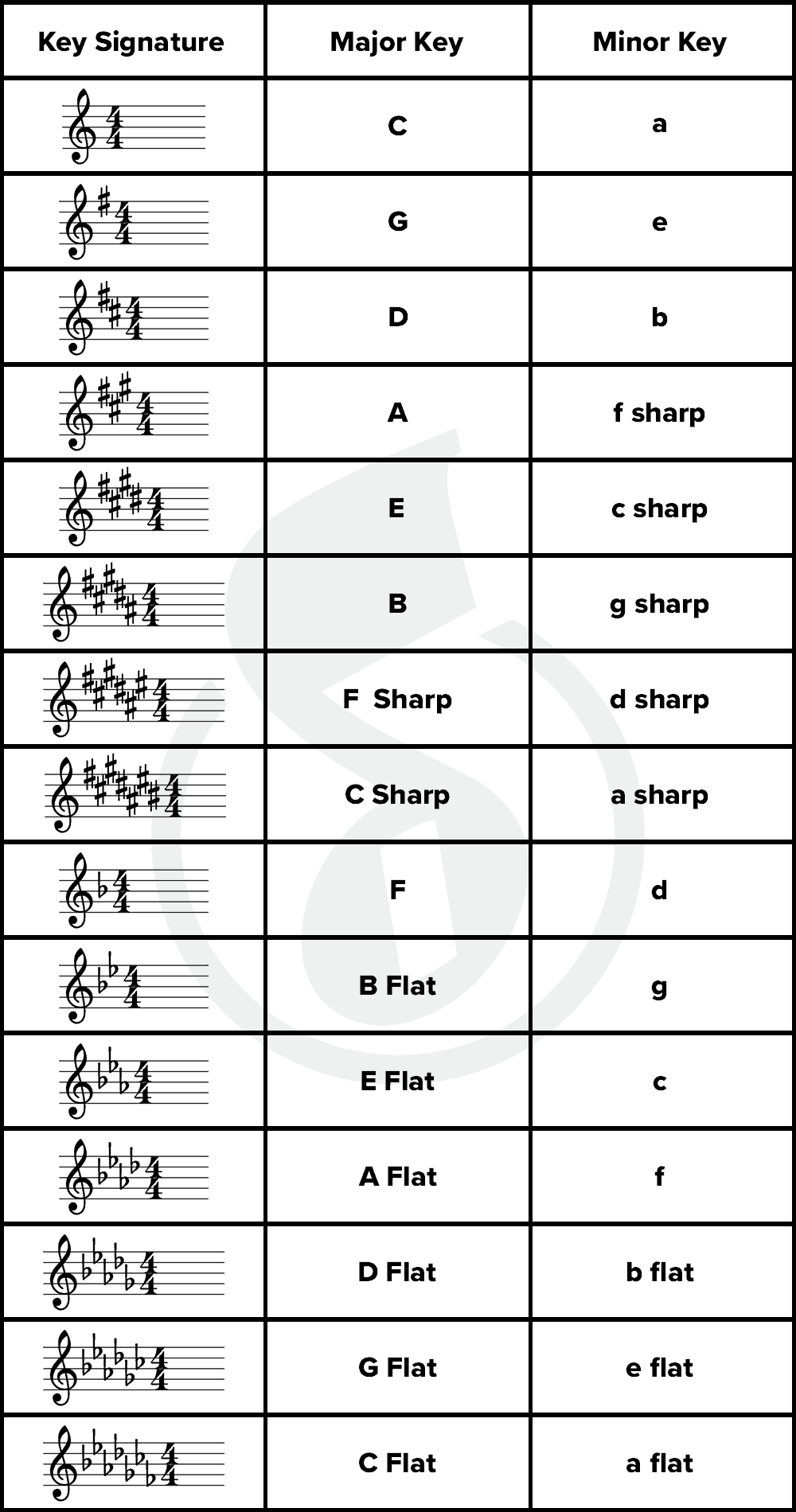
C Major and A Minor
Though we are about to show you some useful tricks, the first thing you need to know when memorizing your key signatures is that there is no trick for C Major or A Minor. Both C Major and A Minor have no accidentals in their key signature, so you will have to memorize these without any hints! The key signature for these keys looks like this:

Here is how they look written as scales:


Major Sharp Keys

When you are approached with a sharp (♯) key in your sheet music, you can determine the corresponding major key by observing the last sharp (or the sharp furthest to the right) in the key signature. Look at the example below and see the sharp highlighted in green.
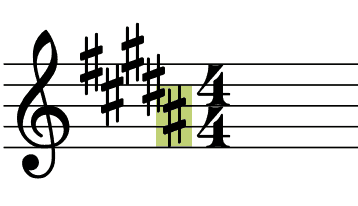
To determine the major key, all you have to do it go one half-step up from the last sharp listed.
- In this example, an A-Sharp is highlighted.
- One half-step up from A-Sharp is B.
- The key is B Major.
Another way to think of this method is to think of the last sharp listed as the leading tone of the major key. In B Major, the leading tone (or 7th scale degree) is A-Sharp.
Now that you know the hack, you can easily use this trick on any other key containing sharps.

Here's an example of B Major written out as a scale. Since there is a key signature, you wouldn't need to add the accidentals, but we have added them to show you which notes are sharp:

Major keys will have a brighter, happier sound when you listen to music composed in a major key. Pieces in a major key will be composed mostly of major chords and will usually resolve to a major chord.
Major Flat Keys

If you thought that was easy, our trick for memorizing your major flat keys (♭) is even easier! With flat key signatures, all you have to do is look to the second flat from the right to determine the major key.
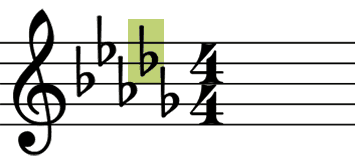
In the example above, notice that a D-Flat is highlighted in green. And just like that, D Flat Major is the key! No additional steps required!

We have to admit, there is one catch with this trick. Since the key of F Major only has one flat, it’s impossible to locate the second flat from the right in that key signature. So just like you’ll have to wire C Major and A Minor into your brain with no extra help, you’ll have to do the same for F Major.

F Major only has one flat: B-flat.
Minor Keys
The true key to memorizing your minor keys is memorizing your major keys first! Once you know which major key signature you are in, you can find its relative minor key in seconds!
To determine the minor key, simply go down a minor third from the major key.
You can think of a minor third as 1.5 steps, three half steps, or one whole-step and one half-step. Choose the method that makes the most sense to you!
Now, let’s put this trick into practice! Say you are given the key signature below:

We can determine by using the trick we learned earlier that one half-step up from F Sharp is G, therefore we are in G Major. Now, to find the relative minor key, find the note a minor third below G.
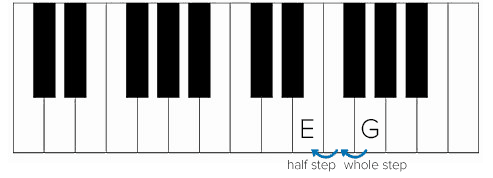
Looking at the image above, you can determine that the relative minor key for G Major is E Minor.
If this method is a little too confusing, you can also find the relative minor by determining the sixth scale degree in the major key. E is the sixth note (or scale degree) in the G Major scale.

Minor keys will have a darker, sadder sound when you listen to music composed in a minor key. Pieces in a minor key will be composed mostly of minor chords and will usually resolve to a minor chord.
The Order of Accidentals
Memorizing the order of sharps and flats in the key signatures is super helpful when identifying major and minor keys.
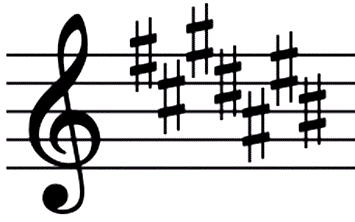
The order of sharps is F – C – G – D – A – E – B.
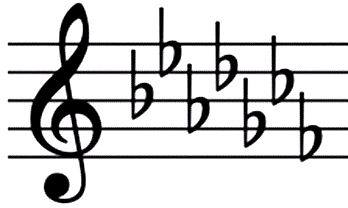
The order of flats is B – E – A – D – G – C – F.
Note that the order of flats is simply the reverse order of the sharps. In reality, you only need to memorize either the order of sharps or flats, not both.
When you have the order of sharps and flats committed to memory, you can visualize the “circle of fifths” in your head to identify major and minor keys. The circle of fifths is a way to remember the order of keys; it shows the relationship among the 12 tones of the chromatic scale, their corresponding key signatures, and the associated major and minor keys. With C major as the starting point, as you move clockwise in fifths, one sharp is added to the key signature. As you move counterclockwise, you add one flat to the key signature.
Looking at the circle:
- the outer section shows the actual key signatures
- the capital letters represent the corresponding major keys
- the lowercase letters represent the corresponding minor keys

- Enharmonic equivalents are the areas where two keys are listed (keys that share the same key signature). The two keys are shown because both key signatures are commonly used. For example: G♭ and F#
Parallel Major / Minor Keys
The above picture of the Circle of Fifths shows relative major and minor keys, which are keys that share the same key signature, like C major and A minor, for example.
Parallel keys are major and minor keys that have different key signatures but share the same starting note, or “tonic”. For example, G Major and g minor share the same tonic, but have different key signatures:


Practice Tips & Exercises
The more you play, the more keys you’ll come across and familiarize yourself with over time. Keep in mind these helpful practice tips as you learn to play in different keys:
- Always look at the key signature before playing a piece.
- After determining the key, look for the notes that are sharp or flat. If you need help remembering which notes to play sharp or flat, you can mark them in your sheet music.
- To determine if the sheet music is in a major or minor key, play the music and listen to hear if it sounds major or minor.
- Learn scales in new keys. If you're new to playing scales, start simple with scales like F or G.
- Find sheet music with the same key of the scale you just learned. Look for something a little below your level to practice so that you can focus on playing well in a new key.
- Keep the new key you are playing in mind as you practice your music. If your song is in the key of G, notice that G is your tonal center as you play. Take note of the F sharps and see how they add a unique color to your music in place of F naturals.
A great way to memorize and familiarize yourself with the major and minor keys, aside from playing pieces in various keys, is to practice scales and arpeggios. We have free piano scales and arpeggios for you to download and print here!
And if you would like, check out this video overview on key signatures:
Now that you know the secrets, you are well on your way to becoming a key signature expert! All that is left is to practice!

FAQ
What are the 15 key signatures?
There are 15 major and minor key signatures.
The major keys include: C, G, D, A, E, B, F sharp, C sharp, F, B flat, E flat, A flat, D flat, G flat, and C flat.
The minor key include: a, e, b, f sharp, c sharp, g sharp, d sharp, a sharp, d, g, c, f, b flat, e flat, and a flat.
How do you find key signatures?
In Western musical sheet music, the key signature is located immediately after the treble and bass clefs before the first line of music.
What is the rule for finding minor keys?
The key to mastering minor keys is to first memorize your major keys. To find the minor key, you move down a minor third from the relative major key. A minor third can be seen as three half steps or pitches or as one whole step and one half step. Another way to find the minor key is to identify the sixth scale degree of the major key. The 6th pitch is the minor key.
How do you remember major and minor keys?
You can remember major and minor keys by several methods, but the easiest is by identifying the key using the key signature. To identify a major sharp key, simply move one half step up from the last sharp listed in a key signature, To identify a major flat key, find the second flat from the left in the key. This flat identifies the actual major flat key. After you have confirmed what major scale you are in, you can find the relative minor key by moving 3 half steps down from the major key.
Related Articles:
- https://www.musicnotes.com/blog/circle-of-fifths-guide/
- https://www.musicnotes.com/blog/4-ways-to-identify-major-and-minor-keys/
- https://www.musicnotes.com/blog/chord-progression-formulas/
Shop Related Products:

